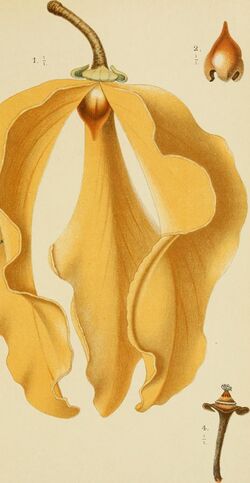Biology:Goniothalamus giganteus
| Goniothalamus giganteus | |
|---|---|

| |
| Color illustration of Goniothalamus giganteus.[1] | |
| Scientific classification | |
| Kingdom: | Plantae |
| Clade: | Tracheophytes |
| Clade: | Angiosperms |
| Clade: | Magnoliids |
| Order: | Magnoliales |
| Family: | Annonaceae |
| Genus: | Goniothalamus |
| Species: | G. giganteus
|
| Binomial name | |
| Goniothalamus giganteus Hook.f. & Thomson
| |
| Synonyms | |
|
Goniothalamus oxycarpus (Miq.) Miq. | |
Goniothalamus giganteus is a species of plant in the family Annonaceae. It is native to Malaya, Myanmar, Sumatra and Thailand.[2] Joseph Dalton Hooker and Thomas Thomson, the British botanists who first formally described the species, named it after its exceptionally large (giganteus in Latin) flowers.[3][4]
Description
Its young branches are smooth and its older branches have white bark with a wrinkled surface. Its petioles are 8 millimeters long. Its leathery, stiff leaves are 16.2–27 by 4.8-8.1 centimeters. The upper surfaces of the leaves are shiny and dark green, while the undersides are paler. Its large yellow flowers are on 2.7–4.1 centimeters long peduncles that are in axillary positions. Its 3 broad, oval sepals are 1.8 centimeters long and come to a blunt point at their tips. The sepals have woolly hairs on both surfaces. Its flowers have 6 petals in two rows of 3. Its outer petals are 10.8 by 5.4 centimeters with a clawed base and wavy margins. Both sides of the outer petals have fine hairs and the base of the inner surface has golden silky hairs. The inner petals have dense silky hairs and are united in the upper 1.8 centimeters of their margins. The flowers' receptacles are flat and hollowed out in the middle. It has numerous stamen. Its ovaries are linear to oblong. Its styles are filiform with slightly club-shaped tips.[4][5]
Reproductive Biology
Its pollen is shed as permanent tetrads.[6]
Habitat and Distribution
It has been observed growing in evergreen forests, swampy lowlands, and hillsides at elevations of 0 to 900 meters.[6]
Uses
Bioactive compounds extracted from its bark have been reported to have cytotoxic activity in tests with cultured human cancer cells.[7][8]
References
- ↑ Herzsohn, Paul (1890). "Ueber Kleistogamie Im Weiteren Sinne Und Das Knight-Darwin'sche Gesetz" (in de). Annales Jardin Botanique de Buitenzorg 8 (2): 123–145. https://archive.org/details/annalesdujardinb08kebu. Retrieved April 15, 2020.
- ↑ "Goniothalamus giganteus Hook.f. & Thomson". The Trustees of the Royal Botanic Gardens, Kew. n.d.. https://powo.science.kew.org/taxon/urn:lsid:ipni.org:names:73195-1.
- ↑ Stearn, William (2004). Botanical Latin. Portland, Ore. Newton Abbot: Timber Press David & Charles. ISBN 9780881926279.
- ↑ 4.0 4.1 Hooker, Joseph Dalton; Thomson, Thomas (1855) (in en, la). Flora Indica. London: W. Pamplin. p. 109. https://www.biodiversitylibrary.org/item/105730.
- ↑ Ridley, Henry Nicholas (1922). The flora of the Malay Peninsula. 1. London: L. Reeve & co., ltd.. p. 65. https://www.biodiversitylibrary.org/item/42256.
- ↑ 6.0 6.1 Saunders, Richard M. K.; Chalermglin, Piya (2008). "A synopsis of Goniothalamus species (Annonaceae) in Thailand, with descriptions of three new species". Botanical Journal of the Linnean Society 156 (3): 355–384. doi:10.1111/j.1095-8339.2007.00762.x. ISSN 0024-4074.
- ↑ Fang, Xin-ping; Anderson, Jon E.; Chang, Ching-jer; McLaughlin, Jerry L. (1991). "Three new bioactive styryllactones from goniothalamus giganteus (Annonaceae)". Tetrahedron 47 (47): 9751–9758. doi:10.1016/S0040-4020(01)80715-8. ISSN 0040-4020.
- ↑ Alali, Feras Q.; Rogers, Lingling; Zhang, Yan; McLaughlin, Jerry L. (1998). "Unusual bioactive annonaceous acetogenins from Goniothalamus giganteus". Tetrahedron 54 (22): 5833–5844. doi:10.1016/S0040-4020(98)00286-5. ISSN 0040-4020.
Wikidata ☰ Q15358686 entry
 |

